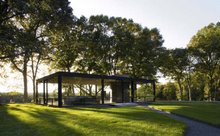I'm a day behind - so again I'm going to merge two days. I know armchair travelling - and keeping up with this veneer of an intellectual discourse - is challenging. But stick with me here as we are wrapping up at the best sites of all.
The high level? Obviously it takes a group to define a movement - of course this is a repeated phenomenon seen here with Gropius, Mies, Klee etc at the Bauhaus or with "the kids" at the Glass House.
So our morning is spent driving to Dessau to see the Bauhaus. Breathtaking. This school moved in 1925, giving it a unique opportunity to build their building + housing in a style evocative of the new movement they were defining. New technical maneuvers (glass curtain wall suspended in front of the load bearing framework) and new functional order (separating workshops from classrooms from office all have distinct visual translations.). May all seem standard practice to us by now but even the view of art, architecture and design together was entirely unique.
Of course Mies didn't design the Bauhaus - Gropius did, as he lead it and then later came to America to head Harvard into the modern movement, which we all know is where our friend PJ went. (Excuse the shorthand as I'm typing this on my backberry so you are all sympathetic).
Mies did, however, lead the Bauhaus later, and then coming to America lead IIT's program and designed much of that campus. We visited the Bauhaus masterhouses - where such people as Kandinsky, Klee, Schlemmer and Feininger lived. Also visited the Kornhaus, steel house, then Gropius' Torten estate (Levittown for germany in the 1920s) and employment office (which uses this brilliant full skylight ceiling (also 1920s).
Light on details but I'm getting to a highlight whcih was a boat tour of the Woerlit gardens. SPECTACULAR. Phyllis Lambert said that this 18th century landscape and its many follies was much loved by PJand was a source inspiration for the Glass House site's follies such as the ghost house, the lake pavillion and the Kierstein tower. Not a surprise as it was captivatingly beautiful, at each moment of just recovering from one beautiful folly another one would reveal itself. Little hamlet bridge, landscape, glorious castle in the distance, more landscape, another hobbit type bridge, landscape, tyrolean stick bridge............
The boats had an oarsman - our was lucas the near olympic rower - and a table set down the center. Outside eating we drank every bottle on our boat and had the inkling of capsizing another boat as they were so much slower on the draw. Two glasses went sideways which is a near miracle given the tenderness of our vessel - but sweet lucas told us that was rare (he must have meant our rare form).
A stumble to the room only to wake about 4 hours later to get on the plane to Stuttgart. Sheer dedication. Our first stop was the Mercedez Benz museum designed by UN studio. Not Mies - just fantastic. The connection might have been use of materials and of course using the new technical tools of the time (or engineering concepts) to interpret space. Second stop was werkbundausstellung weissenhofsiedlung (yes I checked the spelling and think that is right - and of course saying this just sounds as sexy as marbles). For those of you who are modernist junkies this is heaven: JJ Oud, le Corbusier (I should have listed him first!), mies, gropius, sharoun, behrens and taut. A sick list for sure. This german werkbund was founded in 1907 by 12 artists and 12 firms to increase the collaboration between artists, craftsmen and industry to increase the quality of germany's products, buildings and overall design. Mies was the director of this werkbund in 1927 when this experimental settlement was designed. This "new dwelling" has an attmpt at slight community design but is overall more of a showcase for these architects who would exhibit this new "international style."
This community was denounced by the nazis and slated for demolition as they preferred the classic pitched roofs - but the war got in the way - some were damaged and a number remain and are beautifully restored.
We left to go to the Staatsgalerie designed in 1977 by James Stirling and Michael Wilford. Postmodern even turning Schinkel's Altes museum inside out or reversing the sequence and leaving the rotunda (Schinkels point of arrival to the art) as an empty center (a loss of the center - much debated in texts). By now we are so damn tired that we tell our leader that the CIA recently released a report where lack of sleep and forced marches qualify as torture. And in true stockholm syndrome of course we all love our torturer.......
About Preserve the Modern
- . . . . . . . . . . . . . . . . . . . . . . . .
- Preserve the Modern is an initiative led by the Philip Johnson Glass House to focus attention and resources on our nation’s collection of significant Modern buildings in order to document, preserve and protect them. This forum will allow a network of modernists around the world to share their travel experiences visiting modern structures in our region, across the United States, and around the globe. By sharing these modernist travel experiences we aim to raise awareness of these structures as important representations of ideas, lifestyles, as well as cultural and political events that transformed the twentieth century.
Friday, August 24, 2007
Subscribe to:
Post Comments (Atom)

1 comment:
Spouse and I went on a Bauhaus pilgrimage, starting in Berlin and doing a big circle around that part of the old East Germany. It was wonderful.
Although we saw Torten from the outside, I don't think any units were open back then. What did you think about them?
Thanks for your link
Hels
Art and Architecture, mainly
Post a Comment